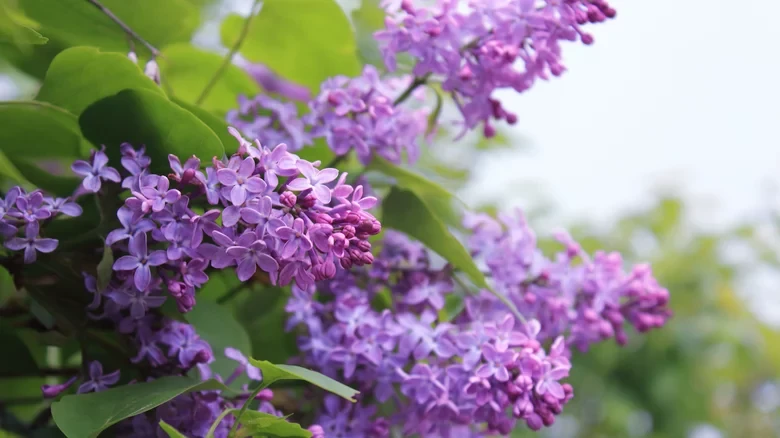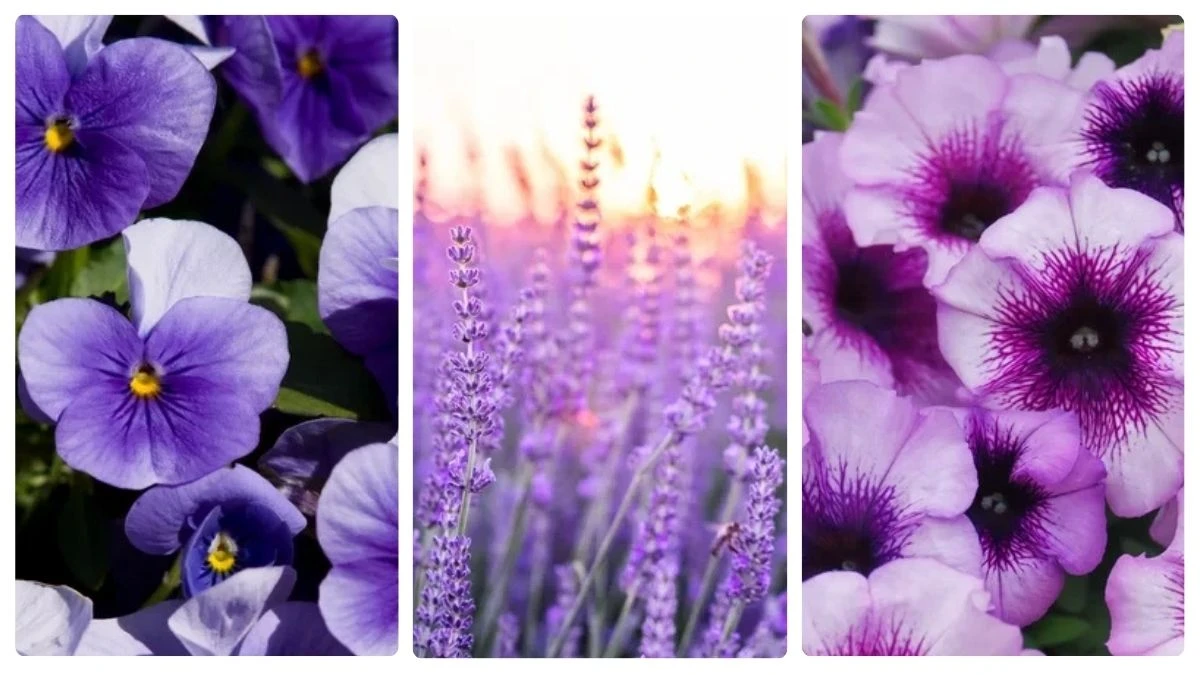Want bold-colored purple flowers to make your garden pop out? Envision walking outside to a sea of vibrant purple blooms, each one adding depth, charm, and a touch of magic to your outdoor space. Purple plants are more than just eye-catching; they bring a sense of calm and elegance, and even attract pollinators to create a thriving ecosystem.
Choosing the right purple plants can transform your flower garden into a stunning retreat. From bold blooms to delicate petals, this guide will introduce you to 15 gorgeous purple Flowers to make your garden pop that is easy to grow and impossible to ignore. Let’s turn your garden into a purple paradise.
15 Gorgeous Purple Flowers to Make Your Garden Pop with Color

1. Petunias

Petunias are a popular choice for adding vibrant purple hues to flower gardens. Known for their trumpet-shaped blooms, these plants thrive in full sun and well-drained soil. They bloom profusely from spring to fall, making them a long-lasting addition to any garden.
Research highlights their adaptability, showing petunias can tolerate a range of soil types, though they prefer slightly acidic conditions. Their low maintenance needs make them suitable for both novice and experienced gardeners. Regular deadheading encourages continuous flowering, ensuring your garden stays colorful.
Petunias also attract pollinators like bees and butterflies, contributing to a healthy ecosystem. With varieties ranging from deep violet to soft lavender, they offer flexibility in garden design. Whether planted in beds, containers, or hanging baskets, petunias bring a lively touch to outdoor spaces.
2. Lilac

Lilacs are cherished for their fragrant, purple blossoms, which signal the arrival of spring. These hardy shrubs prefer full sun and well-drained soil and thrive in cooler climates. A study by the University of Toledo notes that lilacs are excellent indicators of climate change due to their sensitivity to temperature shifts.
Their blooms, which last for about two weeks, are a magnet for pollinators like hummingbirds and butterflies. Pruning after flowering helps maintain their shape and promotes healthier growth the following year. Lilacs can grow large, making them ideal for creating natural hedges or focal points in larger gardens.
Their timeless beauty and dreamy scent make them a favorite among gardeners. With proper care, these plants can live for decades, becoming a lasting part of your landscape.
3. Allium

Alliums, often called ornamental onions, are unique additions to any garden with their spherical purple blooms. These plants are part of the onion family but are grown for their striking flowers rather than their edible qualities. Research from the Royal Horticultural Society shows that alliums are highly resistant to pests and diseases, making them a low-maintenance option.
They thrive in full sun and well-drained soil, often blooming in late spring to early summer. Their tall, sturdy stems make them excellent for adding vertical interest to garden beds. Alliums are also deer-resistant, a valuable trait for gardeners in areas with wildlife.
Their blooms can be dried and used in floral arrangements, extending their usefulness beyond the garden. With varieties ranging from small clusters to large globes, alliums offer versatility and visual impact.
4. Lavender

Lavender is a classic purple plant known for its soothing fragrance and versatility. This hardy perennial thrives in full sun and well-drained soil, often flourishing in dry, rocky conditions. A study from the University of Maryland Medical Center highlights lavender’s calming properties, which have been used for centuries in aromatherapy.
Its slender purple spikes bloom in summer, attracting bees and other pollinators. Lavender requires minimal watering once established, making it a drought-tolerant choice for sustainable gardens. Pruning after flowering helps maintain its shape and encourages new growth.
Beyond its ornamental value, lavender can be harvested for use in sachets, teas, and essential oils. Its silvery-green foliage provides year-round interest, even when not in bloom. Whether planted in borders, containers, or herb gardens, lavender adds both beauty and functionality to outdoor spaces.
5. Bellflowers

Bellflowers, or Campanula, are charming perennials known for their bell-shaped purple flowers. These plants thrive in full sun to partial shade and prefer moist, well-drained soil. Research emphasizes their resilience, as they can adapt to various growing conditions.
Blooming from late spring to early summer, bellflowers attract pollinators like bees and butterflies. Their low-growing varieties are excellent for ground cover, while taller types add height to garden beds. Deadheading spent flowers can prolong their blooming period, keeping your garden vibrant.
Bellflowers are also relatively pest-resistant, requiring little maintenance. With shades ranging from deep violet to soft lavender, they offer a wide palette for garden design. Their delicate appearance and hardy nature make them a favorite among gardeners looking for both beauty and durability.
6. Clematis

Clematis is a stunning climbing vine that adds vertical beauty to gardens with its vibrant purple flowers. These plants thrive in well-drained soil and prefer their roots shaded while their tops bask in full sun. A study by the University of Illinois Extension notes that clematis benefits from a layer of mulch to keep roots cool and moist.
The plant blooms from late spring to early fall. depending on the variety, clematis offers a long season of color. Their flowers range from deep violet to soft lavender, providing versatility in garden design. Regular pruning helps maintain their shape and encourages more blooms. Clematis is also known for attracting pollinators like bees and butterflies, enhancing the garden’s ecosystem.
With proper support, such as trellises or fences, these vines can grow up to 10 feet tall, making them ideal for creating natural screens or focal points. Their elegance and adaptability make them a favorite among gardeners.
7. Purple Cornflowers

Purple cornflowers, also known as bachelor’s buttons, are hardy annuals that bring a pop of color to any garden. These plants thrive in full sun and well-drained soil, tolerating poor soil conditions with ease. These flowers are drought tolerant, making them a sustainable choice for dry climates.
These vivid purple flowers attract bees and butterflies, supporting pollinator health. Cornflowers are low-maintenance, requiring minimal watering and care once established. Their long stems make them excellent for cut flower arrangements, adding a rustic charm to bouquets.
These flowers self-seed readily, often returning year after year without replanting. Their vibrant hue and easy-going nature make them a popular choice for wildflower gardens and borders. Plant them in masses or scattered among other blooms, purple cornflowers add a cheerful touch to any landscape.
8. Morning Glory

Morning glories are fast-growing vines known for their striking purple trumpet-shaped flowers. These plants thrive in full sun and well-drained soil, often blooming from early summer to the first frost. Morning glories are highly adaptable, capable of growing in a variety of soil types. Their flowers open in the morning and close by afternoon, giving them their distinctive name.
These vines can quickly cover trellises, fences, or arbors, providing a lush, colorful backdrop. They are also known to attract hummingbirds, adding life and movement to the garden. While they require minimal care, regular watering during dry spells helps maintain their vibrant blooms.
Their ability to self-seed ensures they return year after year, making them a reliable choice for gardeners. With shades ranging from deep purple to soft lavender, morning glories offer both beauty and functionality.
9. Gladiolus

Gladiolus, often called sword lilies, are tall, elegant plants that produce spikes of purple flowers. These plants thrive in full sun and well-drained soil, blooming from mid-summer to early fall. Gladiolus flowers are arranged vertically along the stem, creating a dramatic visual effect in gardens.
Their tall stature makes them ideal for the back of flower beds or as standalone features. These plants are also popular for cut flower arrangements, adding height and color to bouquets. Planting gladiolus corms in succession ensures a continuous display of blooms throughout the season.
While they require staking to support their height, their striking appearance makes the extra effort worthwhile. With shades ranging from deep violet to soft mauve, gladiolus adds a touch of sophistication to any garden.
10. Lupine

Lupines are tall, spiky perennials known for their vibrant purple flower spikes. These plants thrive in full sun and slightly acidic, well-drained soil. A study highlights their ability to fix nitrogen in the soil, improving soil health for surrounding plants. Lupines attract pollinators like bees and butterflies, supporting biodiversity. they bloom in summer.
Lupines are relatively low maintenance but benefit from regular deadheading to encourage reblooming. These plants can grow up to 4 feet tall, making them ideal for adding height and drama to garden beds. Their ability to thrive in poor soil conditions makes them a practical choice for challenging landscapes. With shades ranging from deep purple to soft lavender, lupines bring both beauty and ecological benefits to outdoor spaces.
11. Cosmos

Cosmos are cheerful, daisy-like flowers that bring a burst of purple to any garden. These annuals thrive in full sun and well-drained soil, often flourishing in poor conditions. They are highly drought-tolerant, making them a sustainable choice for dry climates. Their delicate, fern-like foliage contrasts beautifully with their vibrant blooms, which appear from early summer until the first frost.
They also attract pollinators like bees and butterflies, contributing to a healthy garden ecosystem, and are also low-maintenance. With heights ranging from one to six feet, they can be used in borders, wildflower meadows, or as cut flowers.
12. Verbena

Verbena is a versatile plant known for its clusters of small, purple flowers. These hardy perennials thrive in full sun and well-drained soil, often blooming from spring to fall. Verbena spreads quickly, making it excellent for ground cover or spilling over containers. Regular deadheading helps maintain their vibrant blooms and prevents self-seeding.
Their nectar-rich flowers attract butterflies, bees, and other pollinators, enhancing garden biodiversity. Verbena comes in both trailing and upright varieties, offering flexibility in garden design. Their long blooming season and low maintenance needs make them a popular choice for borders, rock gardens, or hanging baskets. With shades ranging from deep purple to soft lavender, verbena adds a splash of color to any setting.
13. Balloon Flowers

Balloon flowers, named for their balloon-like buds, are unique perennials that add charm to any garden. These plants thrive in full sun to partial shade and prefer well-drained soil. They have resistance to pests and diseases, making them a low-maintenance option.
Their purple, star-shaped flowers bloom from mid-summer to early fall, adding color when many other plants have faded. Balloon flowers are slow to establish but can live for years once settled.
Their upright growth habit makes them suitable for borders or mixed beds. Deadheading spent blooms can encourage a second flush of flowers. These plants are also excellent for cut flower arrangements, with their unusual buds adding interest.
Their compact size and hardy nature make them ideal for small gardens or containers. With their whimsical appearance and reliable performance, balloon flowers are a delightful addition to any landscape.
14. Foxglove

Foxgloves are tall, stately plants known for their tubular purple flowers. These biennials thrive in partial shade and moist, well-drained soil. They can attract pollinators like bees and hummingbirds, thanks to their nectar-rich blooms. Foxgloves bloom in late spring to early summer, adding vertical interest to garden beds.
Their rosettes of foliage remain attractive even when not in bloom. While they are short-lived, they often self-seed, ensuring their presence in the garden for years. Caution is advised, as all parts of the plant are toxic if ingested. Foxgloves are excellent for cottage gardens or woodland settings, where their dramatic spikes can shine.
Their rich purple hues and architectural form make them a standout feature in any garden. With proper placement and care, foxgloves bring elegance and ecological benefits to outdoor spaces.
15. Purple Pansy

Purple pansies are beloved for their cheerful, face-like flowers and cool-season blooms. These hardy annuals thrive in full sun to partial shade and prefer well-drained soil. Their blooms appear in early spring and fall, providing color when many other plants are dormant. Regular deadheading encourages continuous flowering, keeping gardens vibrant.
Pansies are versatile and suitable for borders, containers, or ground cover. Their compact size makes them ideal for small spaces or edging pathways. Purple pansies pair well with other cool-season plants, creating striking combinations.
Their rich color and long blooming period make them a favorite for adding early and late-season interest to gardens. With their charming appearance and strength, purple pansies are a must-have for any flower garden.
Final Thoughts!
Your garden deserves to be a reflection of your creativity and love for nature, and purple plants offer the perfect way to make that happen. With their rich hues and unique textures, these blooms can elevate any space, creating a visual masterpiece that changes with the seasons.
With the bold spikes of lupines or the delicate charm of pansies, there’s a purple plant for every style and skill level. So, why wait? Start planting today and watch your garden come alive with color, life, and endless beauty. Your purple paradise is just a few seeds away, let it bloom!

